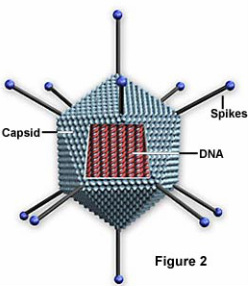
Structure of an Animal Virus (9)
[These terms apply to both bacteriophages and animal viruses]
2) contains special sites on its surface that allow the virion to attach to a host cell
3) provides proteins that enable the virion to penetrate the host cell membrane and sometimes to inject the infectious nucleic acid into the cell's cytoplasm.
[These terms apply to both bacteriophages and animal viruses]
- Capsid - protein shell that encloses the nucleic acid (nucleocapsid is shell plus the nucleic acid), composed of protein organized into subunits called capsomers, has 3 functions:
2) contains special sites on its surface that allow the virion to attach to a host cell
3) provides proteins that enable the virion to penetrate the host cell membrane and sometimes to inject the infectious nucleic acid into the cell's cytoplasm.
- Envelope - composed of two lipid layers interspersed with protein molecules (lipoprotein bilayer), contains material from the membrane of a host cell as well as that from the virus The virus obtains the lipid molecules from the cell membrane during the viral budding process. However, the virus replaces the proteins in the cell membrane with its own proteins, creating a hybrid structure of cell-derived lipids and virus-derived proteins. Many viruses also develop spikes made of glycoprotein on their envelopes to attach to cell surfaces
- Nucleic Acid - encodes the genetic information for the synthesis of all proteins. Most viruses maintain all of their genetic information with the single stranded RNA
Overview of viruses:
- Cannot move, metabolize, respond or evolve on their own (not alive) (7)
- Invade and are reproduced inside living cells (7)
- A complete virus particle is called a virion (8)
- The main function of a virion is to deliver its DNA or RNA genome into the host cell so that the genome can be expressed by the host cell (8)
Classification:
2) Size and shape of capsid
3) Whether they have a lipid envelope surrounding the nucleocapsid
sphere- 20-sided polygon (icosahedron)
- Use the taxonomic levels: order, family, subfamily, genus, species (7)
- Viruses are classified by the organisms they infect: animals, plants or bacteria (10)
- Are further classified into families and genera based on 3 structural considerations (10)
2) Size and shape of capsid
3) Whether they have a lipid envelope surrounding the nucleocapsid
- There are 2 shapes among viruses: rods and spheres (10)
sphere- 20-sided polygon (icosahedron)
